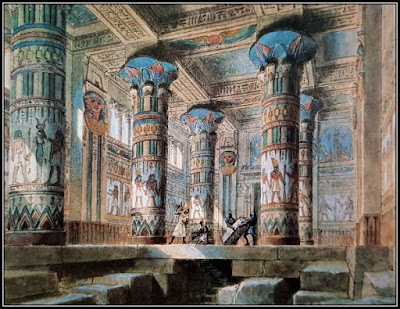 |
| Set design by Philippe Chaperon for Act 4, Scene 2 of Aida by Verdi |
Isma'il Pasha, Khedive of Egypt, commissioned Giuseppe Verdi to compose an opera for performance to celebrate the opening of the Khedivial Opera House, but the premiere was delayed because of the Siege of Paris, during the Franco-Prussian War.
Aida eventually premiered in Cairo in 24 December 1871, conducted by Giovanni Bottesini. It was an immediate success and has remained Verdi's most popular opera ever since. Aida is an opera in four acts and the libretto was writter by Antonio Ghislanzoni.
- Celeste Aida- Gloria all' Egitto
- Triumphal March
- Vieni, o guerriero vindice
- O terra, addio
"Aida" is a story of love, war and betrayal and focuses on the love between a captive Ethiopian princess Aida by the Egyptians and Radamès, the Egyptian captain of the Guard who defeats the invading troops of her father. Radamès, struggles to choose between his love for her and his loyalty to the King of Egypt. To complicate the story further, the King's daughter Amneris is in love with Radamès, although he does not return her feelings.
In Act One, Radamès sings his fiery love for Aida, in aria Celeste Aida (Divine Aida), one of Verdi's most beautiful love songs.
The majestic spectacle for which this opera is famous culminates in Act Two, Stage II, when the King of Egypt and his ministers, the priests, the army and the people, celebrate the triumphant victory.
The wonderful choral Gloria all' Egitto (Glory to Egypt), which begins with a melody in the form of a march, impressed so much the Hevid of Egypt that he wanted to use it as the National Anthem of his country. At the moment the song has slowly slowed down, three "Egyptian" trumpets introduce the most famous music of this opera, the Triumphal March, one of the most impressive and shocking marches ever written.
A lively ballet follows and the choral Gloria all' Egitto returns with the same melody but with other lyrics, Vieni, the guerriero vindice (Come, victorious warrior), who welcome Radamès and proclaim him the savior of Egypt.
The opera ends with the exquisite and heartbreaking duet O terra, addio (Goodbye Earth). Radamès and Aida accept their death and sing this charming melody, at first separately and then together. The chanting of the priest and the sorrow-broken voice of Amneris (The Princess of Egypt who fell in love with Radamès) are joined by the dying hymn of the two lovers.
Comments
Post a Comment